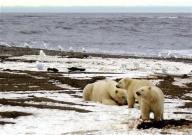Mon Mar 16, 2009 10:32am EDT

By John Acher
OSLO (Reuters) - Global warming is threatening polar bears as it melts their
icy Arctic habitat, Norway's environment minister said on Monday.
"If the ice is disintegrating in the Arctic, it will have enormous impact on
polar bears," Environment and Development Minister Erik Solheim told
reporters on the eve of a meeting to discuss the future of the huge white
carnivore.
The meeting is the first since 1981 to bring together states which are home
to polar bears -- Norway, Russia, Canada, the United States and
Danish-administered Greenland.
"Clearly the main point in a rescue plan for the polar bear is to reduce
global warming," Solheim said.
The world's polar bear population is estimated at 20,000-25,000 animals,
with 2,200-4,000 belonging to the Barents Sea population of Norway and
northwestern Russia.
Polar bears spend most of their lives on or near sea ice. Though they are
excellent swimmers, they are no match in the water for seals, their main
prey, so they must hunt on ice floes.
Solheim said it was very helpful that the United States under former
President George W. Bush put the polar bear on the list of endangered
species.
"We should build on that to see what we can do to protect the polar bears,"
he said.
The range states agreed in 1973 to protect polar bears and their habitat,
but they have not met for 28 years.
SOOT A POLAR PROBLEM
James Hansen, director of NASA's Goddard Institute for Space Studies and an
expert on global warming, said pollutants and gases such as soot, ozone and
methane, can be controlled more easily in the Arctic than carbon dioxide
(CO2).
CO2 is the main greenhouse gas blamed for global warming.
Industrial soot, for instance, blackens the snow and makes it soak up more
heat, accelerating the melt.
"Their warming effect in the Arctic is very large," Hansen told a news
conference. "Pollution in the Arctic contributes to the melting of the ice.
Those climate-forcing mechanisms can be addressed more quickly than carbon
dioxide."
Arctic sea ice shrank in 2007 to its smallest since satellite measurements
began 30 years ago, leading to worries that it could vanish in summers.
"I think it's still possible to save sea ice in the Arctic but it
requires strong, prompt actions," Hansen said.
About 700 polar bears are shot yearly in Canada, Alaska and on Greenland.
Since 1973, hunting has been banned in the Svalbard archipelago off
northernmost Norway.
In the Russian part of the Arctic, hunting is illegal, but an unknown number
of bears is shot every year, according to the Norwegian Polar Institute.
(Reporting by John Acher and Alister Doyle; Editing by Angus MacSwan)
© Thomson Reuters 2009 All rights reserved
